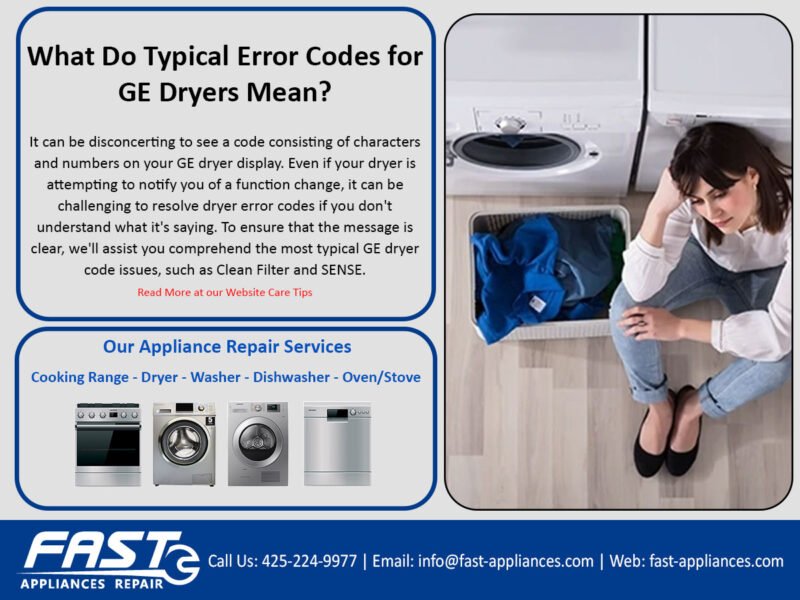
Error codes in appliances, like the F1 on your GE dryer, serve as a helpful alert system. Think of them as the flashing light on your car dashboard, waving to get your attention and hinting that something needs fixing. However, deciphering what they actually mean can be quite the conundrum, especially for beginners. But fear not, let’s unravel this mystery together, step-by-step, and see if your warranty can come to the rescue.
Understanding the F1 Error Code
First things first—what exactly does that annoying F1 code mean? In the GE dryer universe, an F1 error generally points to an issue with the control board. Picture the control board as the brain of your dryer. It coordinates all the operations, from starting the cycle to signaling when clothes are dry. When this essential component hiccups, the entire drying operation can come to a screeching halt, which is what the F1 error is trying to tell you.
Errors like F1 are akin to a toddler throwing a tantrum; they demand attention to ensure everything goes back to smooth sailing. The control board might have taken a hit due to power surges, or maybe it’s just wear and tear. You see, electronic components aren’t immune to the test of time—just like any other gadget in your home.
After understanding the root metaphorically, now comes the question: is a faulty control board covered under warranty? Before diving into that, it’s essential to check your dryer’s manual or the warranty document itself. Most warranties cover manufacturing defects, potentially including a malfunctioning control board. However, conditions and coverage length vary—like a menu at a restaurant, it’s always wise to check the details.
What Does Your Warranty Typically Cover?
You might be wondering, “Does my warranty cover everything?” Well, not quite. Warranties are designed to protect you against defects in materials or workmanship, not accidental damage or misuse. Imagine it’s like insurance for your dryer’s parts—they cover faults the manufacturer is responsible for, not the wear and tear of daily use or accidental mishaps.
With GE dryers, you typically get a one-year warranty that covers the entire appliance. This means if your F1 error is due to a manufacturing issue within this period, you’re in luck! The repair or replacement of the faulty control board may be covered. But here’s the kicker: warranties often have specifics, especially when it comes to high-value components like the control board, which might have a different duration or coverage conditions.
Let’s say your dryer’s control board decides to take an early retirement, and your warranty is still valid—what’s next? Start by contacting GE’s customer support. They’ll guide you through the process, which likely includes sending a certified technician to assess and fix the problem. Remember, like in any business agreement, thoroughness pays off. Keeping all your purchase records and warranty documentation can ease this process significantly.
Steps to Take When Facing the F1 Error
So, what should you do when that pesky F1 code blinks at you? Start by turning off your dryer and unplugging it for a minute. Think of it as giving your dryer a quick reset, just like you do with your smartphone when it starts acting up. If the error persists, it’s time to delve deeper or call in the cavalry—GE’s support team.
In the meantime, check for any physical damages or noticeable electrical issues. Sometimes simple problems, like a loose connection, might be miscommunicated as an F1 error. It’s like calling the fire department for a burnt toast alert—not quite necessary, right? Yet, it’s better to be safe than sorry.
If your warranty period has lapsed, don’t panic. All hope isn’t lost. Consider reaching out to a qualified appliance repair service. They can provide a diagnosis and discuss repair costs, which might be less daunting than purchasing a brand-new dryer. Regular maintenance and periodic check-ups can also keep these errors at bay, much like regular exercise keeps your body in shape.
Prevention and Maintenance Tips
Prevention is often better than cure. Maintaining your dryer can prevent errors, extending its lifespan significantly. Treat your dryer gently; overloading it is like asking a small car to pull a heavy trailer—not exactly ideal. Regularly clean the lint filter and exhaust vent, ensuring smooth airflow and reducing the risk of errors.
Think of the dryer as a team player in your household chores ensemble. Regularly cleaning the internal components can prevent overheating and reduce the strain on the control board, much like regular oil changes keep a car running smoothly. These small steps can mean fewer error codes and more hassle-free laundry days.
If you’re curious about how to perform basic maintenance, consider consulting online tutorials or your dryer’s manual for guidance. Engaging in these small acts of care can save you from costly repairs and keep that F1 code from making unwelcome encore appearances.
In conclusion, dealing with the F1 error code doesn’t have to be daunting. By understanding your warranty, taking proactive steps, and maintaining your dryer properly, you can keep your appliance running efficiently for years to come. So, next time you spot that F1 code, you’ll know just what to do, and you’ll be better prepared to keep your laundry routine on track.